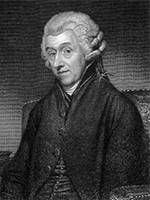As far as medical mysteries go, the case of "Dr. Anonymous" is legendary. It has evoked intrigue for two centuries and includes some the biggest names in the history of medicine. And this mystery's final unraveling, by Dr. Paul Kligfield, a professor of medicine at Weill Cornell Medical College, was the result of a quarter-century of historical research, and not just a bit of luck.
"The strange case of 'Dr. Anonymous' is a tale of discovery, of medical history, of bibliomania and serendipity," said Dr. Kligfield, who told the tale during a lecture of the Heberden Society at Weill Cornell Medical College on Oct. 22.

William Heberden
The story begins with William Heberden himself, the namesake of the society and a London physician who was among the most famous of the late 18th century. In 1772, Heberden published a paper titled "Some Account of the Disorder of the Breast" in the journal Medical Transactions of the Royal College of Physicians of London. Heberden's description of angina pectoris, or heart attack, was the first in the history of medicine, and it was so well written that subsequent historians have described it as "the most concise and precise original description of disease in the history of medicine."
Soon after the paper was published, Heberden received an anonymous letter from a correspondent describing his own chest pain in extraordinary detail. (It is so clear, in fact, that Dr. Kligfield, a cardiologist, can diagnose it today — ventricular arrhythmia with postextrasystolic potentiation). The anonymous author expressed fear that he would die suddenly in the near future and offered his body to Heberden for autopsy.
Three weeks later, the correspondent died, just as he had predicted; his will included a request that Heberden be notified. An autopsy was done by a local physician and Heberden later reported the results of the autopsy in the 1785 edition of the journal Medical Transactions.
Over the next 200 years, scholars unearthing the history of the heart attack speculated about who the anonymous correspondent might have been; because of the detail of his descriptions, he came to be known as "Dr. Anonymous" in the history of cardiology. Guesses abounded, but no one could definitively pinpoint who "Dr. Anonymous" was.
That was until 1982, when Dr. Kligfield serendipitously found a 1785 first-edition copy of Medical Transactions, which included a reprint of the entire Heberden–"Dr. Anonymous" correspondence, while he was nosing around a bookshop in London.
Under the closing salutation "Unknown" in this particular copy of Medical Transactions, the words "Mallet/formerly of Exeter" was neatly written in an 18th-century hand. Was this Mallet the legendary "Dr. Anonymous" about whom speculation had swirled for two centuries?
Looking deeper, Dr. Kligfield then searched the obituaries of The London Evening Post for a Mallet who had died three weeks after the date of the original letter.
Sure enough, one May 1772 edition of the Post listed the death of "Mr. John Mallet, formerly of Exeter, merchant." Eventually, Dr. Kligfield tracked Mallet to Bunhill Fields, a cemetery in Central London that is also home to poet William Blake and "Pilgrim's Progress" author John Bunyan.
Dr. Kligfield found a 1770 edition of "Baldwin's Complete Guide," essentially a "Who's Who" of 18th-century London, which listed "John Mallet, formerly of Exeter" as a prominent merchant who lived at Number 9, Westmoreland Buildings, Aldersgate Street, not far from the cemetery in which he was buried. As Dr. Kligfield discovered, it turns out that for all his storied history in the annals of cardiology, "Dr. Anonymous" was no doctor at all.

